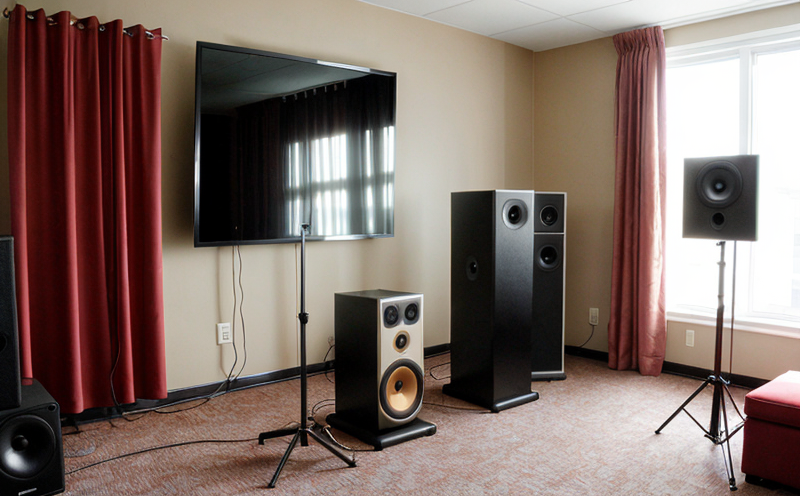ISO 16832 Sound Quality Metrics Testing (Sharpness)
The ISO 16832 sound quality metrics test is a critical tool in psychoacoustics and human perception testing, particularly when assessing the sharpness of auditory stimuli. Sharpness is an important aspect of sound quality that influences listener comfort and satisfaction, especially for products such as audio equipment, HVAC systems, or any device emitting audible signals.
Sharpness is defined by ISO 16832 as the strength with which a listener can perceive a difference in the location from which a sound originates. This metric is measured using a psychoacoustic model that simulates human auditory perception under controlled conditions. The standard provides guidelines for testing sharpness, ensuring consistency and reliability across different environments.
The test setup involves precise measurement of sound waves at specific frequencies and levels to determine how they are perceived by the listener. This requires advanced acoustics equipment capable of generating and analyzing complex sound patterns in real-time. The process is designed to simulate real-world scenarios, ensuring that the results reflect genuine listening experiences.
Testing sharpness involves a series of steps where sound stimuli are presented to listeners under controlled conditions. These stimuli can be varying tones or noise bursts with specific frequency components and levels. Listeners are asked to identify the point at which they perceive a change in the location of origin of these sounds. The data collected is then analyzed using algorithms based on ISO 16832 specifications.
The sharpness metric provides valuable insights into how sound sources are perceived by human listeners, allowing for improvements in design and manufacturing processes. This can lead to quieter, more comfortable environments or devices that better match user expectations. Compliance with this standard ensures that products meet international quality benchmarks, enhancing their marketability and safety.
- Sharpness testing helps manufacturers identify areas where sound sources could be improved for comfort and clarity.
- This process aids in the development of quieter environments by reducing unwanted noise levels.
- The results from this test are essential for ensuring that products meet international quality standards, thus enhancing their marketability.
Benefits
Implementing ISO 16832 sound quality metrics testing (sharpness) offers numerous advantages to businesses and organizations involved in acoustics, vibration & noise testing. These benefits extend across various sectors including audio equipment manufacturing, HVAC design, automotive engineering, and consumer electronics.
Firstly, compliance with ISO 16832 ensures that products meet international quality standards, which is crucial for market access in many countries. This standardization helps build trust among consumers who are increasingly concerned about product performance and safety. Secondly, by accurately measuring sharpness, companies can enhance the user experience through more precise sound design.
Thirdly, conducting this type of testing allows businesses to identify potential issues early in the development process, enabling timely corrections that can save costs and improve overall product quality. Additionally, the insights gained from such tests contribute significantly to R&D efforts aimed at creating innovative solutions for noise reduction and sound enhancement.
Finally, adopting ISO 16832 promotes consistency across different testing facilities worldwide, facilitating easier collaboration between manufacturers and regulatory bodies. This global harmonization is particularly beneficial in industries where compliance with international standards is mandatory or highly valued.
Quality and Reliability Assurance
- The ISO 16832 sharpness test ensures that sound quality metrics are consistent and reliable across different testing facilities.
- This standardization is essential for maintaining high-quality products that meet international standards, thereby enhancing marketability and safety.
- By adhering to this methodology, manufacturers can ensure their products perform optimally under various conditions, leading to increased customer satisfaction and loyalty.
- The rigorous nature of the ISO 16832 sharpness test guarantees that any discrepancies in sound perception are accurately identified early in the development process, allowing for prompt corrective action.
International Acceptance and Recognition
The ISO 16832 sound quality metrics test (sharpness) enjoys widespread acceptance and recognition among various international standards bodies. Its adoption reflects the global commitment to improving the quality of life through better acoustics management.
This standard is part of a broader set of guidelines designed to enhance human comfort by addressing auditory discomfort caused by poor sound design. By adhering to ISO 16832, organizations demonstrate their dedication to excellence in acoustics engineering and human perception testing.
Many industries rely on this metric for ensuring consistent product quality across diverse market segments. Its acceptance by major global manufacturers underscores its importance in shaping modern acoustic practices. Compliance with ISO 16832 also facilitates smoother interactions between suppliers, clients, and regulatory bodies worldwide, fostering a more harmonious industry environment.





